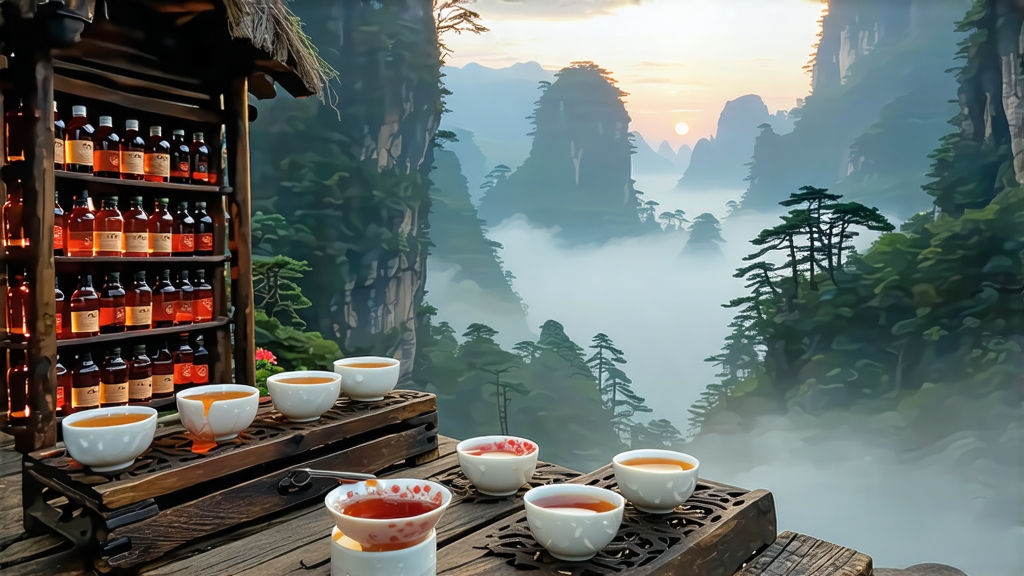
If every tea tells a story, Lapsang Souchong whispers the earliest chapter of black tea. Born in the precipitous Wuyi Mountains of northern Fujian, this leaf was the first in history to be fully oxidised, a technique discovered—so villagers insist—by accident during the late Ming dynasty when passing armies delayed the tea harvest. To save the crop, farmers rushed the leaves over open pine fires; the resulting deep-red liquor and smouldering aroma became the prototype for every black tea that followed.
Today the name “Lapsang Souchong” is protected by origin legislation: only leaves picked within the 600–1 200 m core zone of Tongmu Village and three neighbouring hamlets may bear the title. Outside that radius, even identical cultivars and smoke yield “Wuyi black” or simply “smoked black,” never the genuine article.
Three cultivars dominate the micro-terroir: Xiao Ye Zhong (Small Leaf), Ai Jiao Zhong (Dwarf Foot), and the newer Wuyi Qizhong 105. Each brings a different balance of polyphenols and amino acids, but all must survive the mountain’s mineral-rich, razor-thin soil that forces roots to plunge three metres deep, drawing up the flinty notes that echo in the cup.
Plucking follows the Chinese lunar calendar: the first flush arrives just after Qingming when two leaves and a bud are still tightly folded, shimmering with spring mist. Experienced pickers work clockwise around each bush, snapping the stem with a faint click that signals ideal tenderness—never pulling, which bruises the leaf and invites premature oxidation.
Withering begins within minutes. In Tongmu’s cool April dawn, the leaves are spread on bamboo screens set into slatted windows of three-hundred-year-old smokehouses. Pine and cypress logs, cured for three years, smoulder below; the rising warmth carries resinous smoke through the upper chamber, drying the leaf while impregnating it with volatile guaiacol and syringol. This is not the harsh, tarry perfume later imitators achieved by spraying essence; it is a slow, three-hour conversation between wood and tea that lowers moisture to 60 % and bends the cellular walls without breaking them.
Rolling comes next, entirely by hand. A master craftsman works 5 kg of withered leaf at a time, curling it against the bamboo table with a pressure so subtle that only the cuticle cracks, releasing juices that will oxidise into malty sweetness. The motion resembles kneading dough, yet the wrists never lift—gravity alone supplies the force.
Oxidation is the heart of Lapsang Souchong’s identity. The rolled leaves are piled three centimetres deep in round rattan trays and slid into a stone-walled chamber kept at 24 °C with 80 % humidity. Every fifteen minutes the pile is fluffed to admit oxygen; after two hours the leaf has turned a coppery chocolate, and a scent of longan fruit and honey rises above the lingering smoke. A single mis-timed interval can tilt the cup toward sourness or flatness, so the master gauges progress not by clock but by aroma, a skill passed father to son for seventeen generations.
Firing halts oxidation and locks in the signature smoke. The same pine embers are raked into a narrow trench; trays are stacked above on seven-tiered racks. Temperature climbs in deliberate steps—60 °C, 80 °C, 95 °C—each held until the leaf crackles when squeezed, releasing a final burst of cedar and frankincense. Moisture drops below 7 %, and the leaves glisten with a charcoal frost that will bloom into golden-red liquor in the cup.
Sorting is done by elderly women who shake the finished tea through graduated sieves. Only the evenly twisted, jet-black strands qualify as Zheng Shan (“Original Mountain”) grade; broken bits become Gongfu cuts for export, while dust and stems are steamed into tea-brick filler for the Central Asian market.
Modern connoisseurs encounter two stylistic branches. The traditional “smoked” Lapsang carries a pronounced pine bouquet reminiscent of single-malt Islay whisky and dried winter savoury. A newer “unsmoked” version, developed for western palates sensitive to assertive aromas, omits the final firing over pine, yielding a softer cup of cacao, ripe plum, and Wuyi mineral—yet purists argue it forfeits the very soul that once captivated the courts of Europe